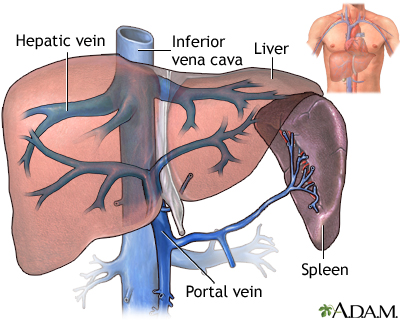Portacaval shunting
Shunt - portacaval; Liver failure - portacaval shunt; Cirrhosis - portacaval shunt
Portacaval shunting is a surgical treatment to create new connections between two blood vessels in your abdomen. It is used to treat people who have severe liver problems.
Images

I Would Like to Learn About:
Description
Portacaval shunting is major surgery. It involves a large cut (incision) in the belly area (abdomen). The surgeon then makes a connection between the portal vein (which supplies most of the liver's blood) and the inferior vena cava (the vein that drains blood from most of the lower part of the body.)
The new connection diverts blood flow away from the liver. This reduces blood pressure in the portal vein and decreases the risk for a tear (rupture) and bleeding from the veins in the esophagus and stomach.
Why the Procedure Is Performed
Normally, blood coming from your esophagus, stomach, and intestines first flows through the liver. When your liver is very damaged and there are blockages, blood cannot flow through it easily. This is called portal hypertension (increased pressure and backup of the portal vein.) The veins can then break open (rupture), causing serious bleeding.
Common causes of portal hypertension are:
- Alcohol use causing scarring of the liver (cirrhosis)
- Blood clots in a vein that flows from the liver to the heart
- Too much iron in the liver (hemochromatosis)
- Hepatitis B or hepatitis C
When portal hypertension occurs, you may have:
- Bleeding from veins of the stomach, esophagus, or intestines (variceal bleeding)
- Buildup of fluid in the belly (ascites)
- Buildup of fluid in the chest (hydrothorax)
Portacaval shunting diverts part of your blood flow from the liver. This improves blood flow in your stomach, esophagus, and intestines.
Portacaval shunting is most often done when transjugular intrahepatic portosystemic shunting (TIPS) has not worked. TIPS is a much simpler and less invasive procedure.
Risks
Risks for anesthesia and surgery in general are:
- Allergy to medicines, problems breathing
- Bleeding, blood clots, or infection
Risks for this surgery include:
- Liver failure
- Hepatic encephalopathy (a disorder that affects concentration, mental status, and memory -- may lead to coma)
After the Procedure
People with liver disease are at a much higher risk for complications after surgery.
People with severe liver disease that is getting worse may need to be considered for liver transplant.
Related Information
Transjugular intrahepatic portosystemic shunt (TIPS)References
Dudeja V, Ferrantella A, Fong Y. The liver. In: Townsend CM Jr, Beauchamp RD, Evers BM, Mattox KL, eds. Sabiston Textbook of Surgery. 21st ed. St Louis, MO: Elsevier; 2022:chap 54.
Rosemurgy AS, Sucandy I. Techniques of portosystemic shunting: selective and nonselective shunts. In: Jarnagin WR, Allen PJ, Chapman WC, et al, eds. Blumgart's Surgery of the Liver, Biliary Tract, and Pancreas. 7th ed. Philadelphia, PA: Elsevier; 2023:chap 84.
Shah VH, Kamath PS. Portal hypertension and variceal bleeding. In: Feldman M, Friedman LS, Brandt LJ, eds. Sleisenger and Fordtran's Gastrointestinal and Liver Disease. 11th ed. Philadelphia, PA: Elsevier; 2021:chap 92.
BACK TO TOPReview Date: 1/31/2023
Reviewed By: Michael M. Phillips, MD, Emeritus Professor of Medicine, The George Washington University School of Medicine, Washington, DC. Also reviewed by David C. Dugdale, MD, Medical Director, Brenda Conaway, Editorial Director, and the A.D.A.M. Editorial team.

Health Content Provider
06/01/2025
|
A.D.A.M., Inc. is accredited by URAC, for Health Content Provider (www.urac.org). URAC's accreditation program is an independent audit to verify that A.D.A.M. follows rigorous standards of quality and accountability. A.D.A.M. is among the first to achieve this important distinction for online health information and services. Learn more about A.D.A.M.'s editorial policy, editorial process and privacy policy. A.D.A.M. is also a founding member of Hi-Ethics. This site complied with the HONcode standard for trustworthy health information from 1995 to 2022, after which HON (Health On the Net, a not-for-profit organization that promoted transparent and reliable health information online) was discontinued. |
The information provided herein should not be used during any medical emergency or for the diagnosis or treatment of any medical condition. A licensed medical professional should be consulted for diagnosis and treatment of any and all medical conditions. Links to other sites are provided for information only -- they do not constitute endorsements of those other sites. © 1997- 2025 A.D.A.M., a business unit of Ebix, Inc. Any duplication or distribution of the information contained herein is strictly prohibited.
